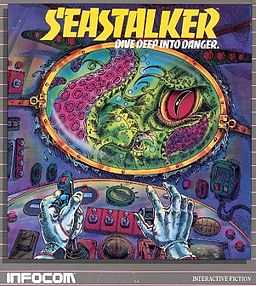Seastalker
| Seastalker | |
|---|---|
 | |
| Developer(s) | Infocom |
| Publisher(s) | Infocom |
| Designer(s) | Stu Galley and Jim Lawrence |
| Engine | ZIL |
| Platform(s) | Amiga, Amstrad CPC, Apple II, Atari 8-bit, Atari ST, Commodore 64, DOS, TRS-80, TI-99/4A, Macintosh |
| Release date(s) | Release 15: May 1, 1984 Release 15: May 22, 1984 |
| Genre(s) | Interactive fiction |
| Mode(s) | Single player |
| Distribution | 3½" or 5¼" disk |
Seastalker is an interactive fiction computer game designed by Stu Galley and Jim Lawrence and published by Infocom in 1984. Like most of Infocom's works, it was released simultaneously for several popular computer platforms of the time, such as the Commodore 64, Apple II, and IBM PC. The game was marketed as an introduction to interactive fiction for pre-teen players. It is Infocom's twelfth game.
Plot
The player's character is a young inventor and marine scientist. A research facility called the Aquadome issues a call for help, indicating that the undersea structure is being attacked by a sea monster. With helpful assistant Tip, the player must navigate to the Aquadome in the new untested two-person submarine Scimitar and investigate the problem. But that isn't all... it looks like there may be a saboteur within the Aquadome as well.
Feelies
With nearly every game, Infocom included extra objects and items called feelies. The Seastalker package held the following feelies:
- A logbook for the Scimitar, including a letter from "The President" congratulating the player on acceptance into the Discovery Squad
- Four double-sided "top secret Infocards", containing hints printed in blue ink beneath a pattern of red ink
- A decoder featuring a small square of red plastic to reveal the hints on the Infocards
- A nautical chart of Frobton Bay for navigation
- A "Discovery Squad badge", a sticker depicting an orca and the motto "Dive deep, dive far"
Notes
Infocom gave Seastalker a difficulty rating of "Junior". It was the only game to ever use this rating, which was replaced by the "Introductory" label given to games such as Wishbringer and Moonmist.
Jim Lawrence, credited as a co-designer for the game, is an author who wrote more than 60 books aimed at children and young adults. Many of his titles were ghostwritten for established series such as Tom Swift, Jr., Nancy Drew, The Bobbsey Twins and The Hardy Boys.
The game has 30 locations.[1]
Reception
Computer Gaming World noted Seastalker 's easiness, recommending it only as a beginner's text adventure, particularly for young kids. Exemplifying this are the numerous tips dropped by both in-game characters and the game itself, directing the player to the included Infocards. The review complained of minor inconsistencies like items that could not be interacted with until an in-game character told the player of its existence.[2]
PC Magazine gave Seastalker 10.0 points out of 12. It also noted the game's relatively low difficulty level, praised the prose, and stated "I enjoyed myself immensely".[3]
Tagline
Dive deep into danger aboard an untested submarine.
References
- ↑ Infocom Fact Sheet, Section VI, Game Statistics
- ↑ Fitzgibbons, Patricia (October 1984), "Micro-Reviews: Seastalker", Computer Gaming World: 38
- ↑ Wiswell, Phil (1984-10-30). "Trolls and Snarks". PC Magazine. p. 273. Retrieved 25 October 2013.